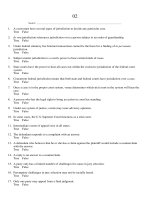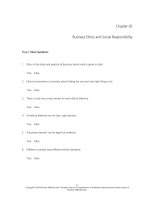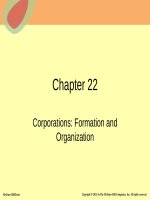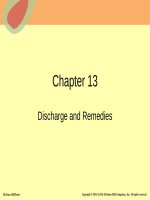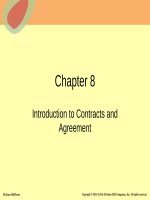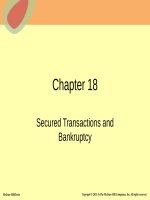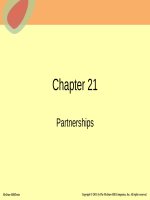- Trang chủ >>
- Thạc sĩ - Cao học >>
- Luật
Lecture Dynamic business law, the essentials (2/e) - Chapter 7: Real, personal, and intellectual property
Bạn đang xem bản rút gọn của tài liệu. Xem và tải ngay bản đầy đủ của tài liệu tại đây (224.64 KB, 18 trang )
Chapter 7
Real, Personal, and Intellectual
Property
McGrawHill/Irwin
Copyright © 2013 by The McGrawHill Companies, Inc. All rights reserved.
Real Property
Definition: Land and everything
permanently attached to it
72
Extent of Land Ownership
• Surface Rights
• Airspace
• Water Rights
• Mineral Rights (Subsurface Rights)
73
Interests In Real Property
• Fee Simple Absolute: Right to possess for
life and devise (will) to heirs upon death; the
most complete interest in real property
• Conditional Estate: Interest comparable to
fee simple absolute, except that interest will
terminate on occurrence/non-occurrence of a
specified condition
• Life Estate: Granted for lifetime of an
individual; right to possess property
terminates upon life estate holder’s death,
and property will pass to another party
designated by original grantor
74
Interests In Real Property
(Continued)
• Future Interest: Person’s right to
property ownership and possession in
the future
• Leasehold Estate: Right to possess
(but not own) property for a stipulated
period of time
75
Nonpossessory Estates
• Easement: Irrevocable right to use some part of
another’s land for a specific purpose, without taking
anything from the land
-Example: Utility easement
• Profit: Right to enter another’s land and take part of
the land, or take away a product of it
-Example: Right to harvest timber
• License: Temporary, revocable right to use
another’s property
-Example: Theatre ticket
76
Voluntary Transfer of Real Property
Requires:
• Execution—preparation and signing of deed;
• Delivery—of deed to grantee, with intent of
transferring ownership to grantee;
• Acceptance—grantee’s expression of intent to
possess and own property
• Recording—filing deed with appropriate county
office to protect interests of grantee
77
Types of Involuntary Transfers:
• Adverse Possession: When person openly
treats real property as his/her own, without
protest/permission from real owner, for
statutorily-established period of time,
ownership is automatically vested in that
person
• Condemnation: Government acquires
ownership of private property for “public
use” for “just compensation” over the protest
of the property owner
78
Intellectual Property
79
Intellectual Property
Definition: Property that comes from
creativity
710
Types of Intellectual Property
• Trademarks
• Trade Dress
• Copyrights
• Patents
• Trade Secrets
711
Trademark
• Definition: A distinctive mark, word, design, picture, or
arrangement used by seller in conjunction with a product
and tending to cause consumer to identify product with
producer
• Mark must be registered with U.S. Patent and Trademark
Office; mark must be renewed between fifth and sixth
years, and after initial renewal, every 10 years
• Remedies for mark infringement:
-Money Damages
-Injunction
• Trademarks used in interstate commerce protected under
Lanham Act
712
Trade Dress
• Refers to the overall appearance and image
of a product
• Entitled to same protection as trademark
• Main focus of trade dress infringement case is
whether there is likely to be consumer
confusion in the comparison of two products
713
Copyright
• Protects the expression of a creative idea
• Examples of copyrighted material include books, periodicals,
musical compositions, plays, motion pictures, sound recordings,
lectures, works of art, and computer programs
• Criteria for a work to be copyrightable:
-Fixed (Set out in a tangible medium of expression)
-Original
-Creative
• Remedies for copyright infringement:
• Money Damages
• Injunction
714
The “Fair Use” Doctrine
Provides that a portion of copyrighted work
may be reproduced for purposes of “criticism,
comment, news reporting, teaching,
scholarships, and research”
715
“Fair Use” Factors
• Purpose and character of use, including
whether use is of a commercial nature or for
nonprofit educational purposes
• Nature of the copyrighted work
• Amount and substantiality of portion used in
relation to copyrighted work as a whole
• Effect of use on potential market for or value
of copyrighted work
716
Patent
• Protects a “product, process, invention, machine, or
plant” that is “novel, useful, and non-obvious”
• Length of protection: 20 years
• Remedies for patent infringement:
-Money Damages
-Injunction
• Lanham Act—allows patent holder to license use of
idea for royalties, provided that holder does not enter
into “tying arrangement” or engage in “crosslicensing”
717
Trade Secret
• Alternative to patent protection
• Definition: A process, product, method of operation, or compilation of
information that gives a businessperson an advantage over his or her
competitors
• Remedies for trade secret infringement:
-Money Damages
-Injunction
• Allows holder to sue for violation, if owner can prove:
-Trade secret existed
-Defendant acquired trade secret through unlawful means
-Defendant used trade secret without plaintiff’s permission
718
